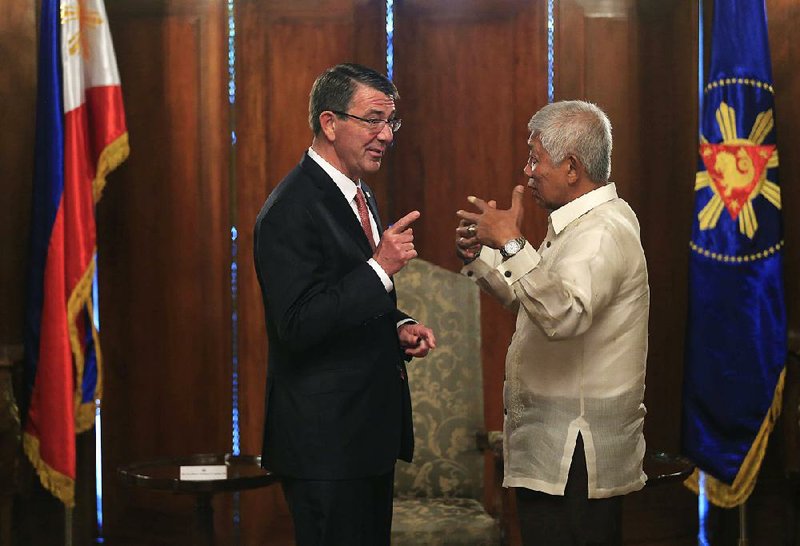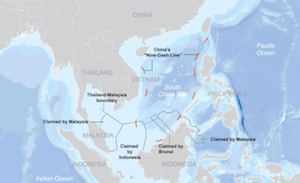MANILA, Philippines -- The United States said Thursday that it will send troops and combat aircraft to the Philippines for regular, more frequent rotations, and will conduct more joint sea and air patrols with Philippine forces in the South China Sea.
The announcement by U.S. Defense Secretary Ashton Carter during a news conference with Philippine Defense Secretary Voltaire Gazmin was the first time the U.S. disclosed that its ships had carried out sea patrols with the Philippines in the South China Sea, a somewhat rare move not done with many other partners in the region.
Carter said that the U.S. did not intend to be provocative and was "trying to tamp down tensions here." But Gazmin said he expected that U.S. forces, "with their presence here, will deter uncalled-for actions by the Chinese."
The increased troop presence is part of a broader U.S. campaign to expand its assistance to the Philippines as the U.S. shores up its allies in the Asia-Pacific that are roiled by China's building of islands in the South China Sea. While the military boost does not include permanent basing for U.S. troops, China views any increased U.S. military presence and activities in the region as a threat.
"Military exchanges by relevant countries should not target third parties, much less support a few countries in challenging China's sovereignty and security, inciting regional contradictions and sabotaging regional peace and stability," the Chinese Foreign Ministry said in a statement in response to Carter's announcement.
China's Defense Ministry later accused the U.S. and Philippines of militarizing the region. A statement posted to the ministry's website said the countries' plans were "nonbeneficial to regional peace and stability" in the South China Sea and was reminiscent of a "Cold War mentality."
"The Chinese military will pay close attention to the situation, and resolutely defend China's territorial sovereignty and maritime interests," it said.
Carter said the U.S. will keep nearly 300 troops, including Air Force special operations forces armed with combat aircraft and helicopters, in the Philippines through the end of the month. The U.S. will increase troop rotations to strengthen training and support increased military operations in the region.
Speaking in the guesthouse of the Philippine presidential complex in Manila, Carter said the joint patrols will improve the Philippine navy and "contribute to the safety and security of the region's waters." Two patrols have taken place since March. The U.S. also has conducted joint patrols with Japan in the region.
Carter has said China's increased actions in the region are compelling more countries to reach out to the U.S., strengthening their military ties with Washington.
The increase in military support comes days after the Philippines' ambassador to the U.S. asked President Barack Obama's administration to help persuade China not to build in the nearby Scarborough Shoal, which is viewed as important to Philippine fishermen. Ambassador Jose Cuisia Jr. said the Philippines cannot stop China from building there. China has built islands in other contested spots in the South China Sea.
Charlito Maniago, the leader of a northwestern Philippine village where many fishermen lost access to the disputed Scarborough Shoal after China seized it in 2012, said the joint patrols will boost hopes that fishermen can again sail freely to the rich fishing ground.
"This will boost the confidence of our fishermen because they think the U.S. has the capability to defend them," Maniago said by telephone from the coastal village of Cato in Pangasinan province. "The presence of America will make China think twice."
The Pentagon said the U.S. forces that will remain in the Philippines are already participating in the Balikatan, or shoulder-to-shoulder combat exercises, that will end today. About 200 airmen, including special operations forces, will remain at Clark Air Base, along with three of their Pave Hawk attack helicopters, an MC-130H Combat Talon II special mission aircraft and five A-10 combat aircraft.
This initial contingent will provide training to increase the two militaries' ability to work together, laying the groundwork for forces to perform joint air patrols.
Up to 75 Marines will stay at Camp Aguinaldo to support increased U.S. and Philippine combined military operations.
The troops and aircraft are expected to leave at the end of April, but other U.S. forces and aircraft would do similar rotations into the Philippines routinely in the future. Carter would not say how frequently those rotations would happen, but called it a "regular periodic presence."
Last week the Pentagon announced that the U.S. will give the Philippines about $40 million in military assistance to bolster intelligence-sharing, surveillance and naval patrols. Carter said the aid will include an enhanced information network for classified communications, sensors for patrol vessels and an unmanned aerostat reconnaissance airship to help the Philippines keep watch over its territory.
The U.S. will get access to five Philippine military bases to house U.S. forces that will rotate in and out of the country for training and other missions.
Information for this article was contributed by Jim Gomez, Christopher Bodeen and staff members of The Associated Press.
A Section on 04/15/2016

